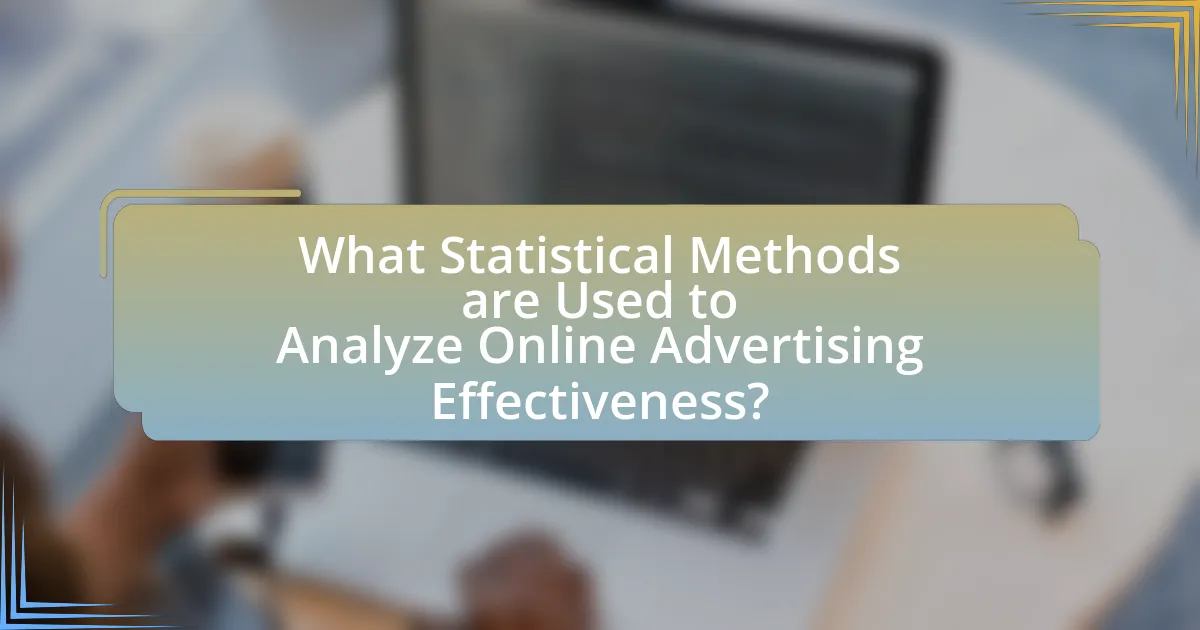The article examines the effectiveness of online advertising through a statistical analysis, highlighting its significant return on investment (ROI) compared to traditional advertising methods. It discusses key performance indicators (KPIs) such as click-through rates, conversion rates, return on ad spend, and customer acquisition costs, which are essential for measuring campaign performance. The article also explores various online advertising formats, their effectiveness, and the impact of audience targeting and ad placement on advertising success. Additionally, it addresses the statistical methods used to analyze effectiveness, common challenges faced in this analysis, and best practices for enhancing online advertising outcomes.

What is the Effectiveness of Online Advertising?
The effectiveness of online advertising is significant, as it has been shown to yield higher return on investment (ROI) compared to traditional advertising methods. According to a study by the Interactive Advertising Bureau, digital advertising can achieve an ROI of up to 300%, demonstrating its capacity to drive sales and engagement effectively. Additionally, a report from eMarketer indicates that businesses allocate approximately 54% of their total advertising budgets to digital channels, reflecting the growing recognition of online advertising’s impact. This data underscores the effectiveness of online advertising in reaching targeted audiences and generating measurable results.
How is effectiveness measured in online advertising?
Effectiveness in online advertising is measured primarily through key performance indicators (KPIs) such as click-through rates (CTR), conversion rates, return on ad spend (ROAS), and customer acquisition cost (CAC). These metrics provide quantifiable data on how well an advertising campaign is performing. For instance, a high CTR indicates that the ad is engaging and relevant to the audience, while a high conversion rate shows that the ad successfully drives desired actions, such as purchases or sign-ups. Additionally, ROAS measures the revenue generated for every dollar spent on advertising, providing insight into the financial effectiveness of the campaign. CAC helps in understanding the cost-effectiveness of acquiring new customers through advertising efforts. Collectively, these metrics allow advertisers to assess and optimize their strategies based on performance data.
What key performance indicators (KPIs) are used to assess effectiveness?
Key performance indicators (KPIs) used to assess effectiveness in online advertising include click-through rate (CTR), conversion rate, return on ad spend (ROAS), and customer acquisition cost (CAC). CTR measures the percentage of users who click on an ad compared to the total number of impressions, indicating engagement levels. Conversion rate reflects the percentage of users who complete a desired action after clicking the ad, showcasing the ad’s effectiveness in driving actions. ROAS quantifies the revenue generated for every dollar spent on advertising, providing insight into profitability. CAC calculates the cost associated with acquiring a new customer, helping to evaluate the efficiency of advertising spend. These KPIs are essential for analyzing the performance and effectiveness of online advertising campaigns.
How do conversion rates impact the perceived effectiveness?
Conversion rates directly influence the perceived effectiveness of online advertising by quantifying the success of marketing efforts in converting potential customers into actual buyers. A higher conversion rate indicates that a larger percentage of visitors are taking desired actions, which suggests that the advertising strategy is resonating well with the target audience. For instance, a study by WordStream found that the average conversion rate across industries is about 2.35%, but the top 25% of companies achieve conversion rates of 5.31% or higher, demonstrating that effective campaigns can significantly enhance perceived effectiveness. Thus, businesses often use conversion rates as a key performance indicator to assess and optimize their advertising strategies.
Why is understanding effectiveness important for businesses?
Understanding effectiveness is crucial for businesses because it directly impacts decision-making and resource allocation. By analyzing the effectiveness of online advertising, businesses can identify which strategies yield the highest return on investment, allowing them to optimize their marketing efforts. For instance, a study by the Interactive Advertising Bureau found that effective online advertising can increase brand awareness by up to 80%, demonstrating the tangible benefits of understanding effectiveness in advertising campaigns. This knowledge enables businesses to enhance their competitive edge and drive growth.
What are the potential financial implications of effective online advertising?
Effective online advertising can significantly enhance a company’s financial performance by increasing sales revenue and reducing customer acquisition costs. For instance, businesses that utilize targeted online advertising strategies can achieve a return on investment (ROI) of up to 400%, as reported by the Digital Marketing Association. Additionally, effective online advertising can lead to improved brand awareness and customer engagement, which further drives sales growth. According to a study by HubSpot, companies that prioritize online advertising see a 13% increase in revenue compared to those that do not. These financial implications underscore the importance of leveraging online advertising to maximize profitability and market reach.
How does effectiveness influence marketing strategies?
Effectiveness directly influences marketing strategies by determining the allocation of resources and the selection of tactics that yield the highest return on investment. When marketers assess the effectiveness of their campaigns through metrics such as conversion rates and customer engagement, they can refine their strategies to focus on channels and messages that resonate most with their target audience. For instance, a study by the Interactive Advertising Bureau found that effective online advertising can increase brand awareness by up to 80%, prompting marketers to prioritize digital platforms that demonstrate measurable success. This data-driven approach ensures that marketing strategies are continuously optimized for better performance and alignment with consumer behavior.

What are the Different Types of Online Advertising?
The different types of online advertising include search engine marketing, display advertising, social media advertising, email marketing, affiliate marketing, and content marketing. Search engine marketing involves paid ads that appear on search engine results pages, while display advertising consists of banner ads on websites. Social media advertising utilizes platforms like Facebook and Instagram to target specific demographics. Email marketing involves sending promotional messages directly to users’ inboxes. Affiliate marketing allows individuals to earn commissions by promoting products or services, and content marketing focuses on creating valuable content to attract and engage audiences. Each type serves distinct purposes and can be measured for effectiveness through various metrics, such as click-through rates and conversion rates.
How do various online advertising formats compare in effectiveness?
Various online advertising formats exhibit differing levels of effectiveness, with display ads, search ads, and social media ads each serving unique purposes and yielding distinct results. For instance, search ads typically achieve higher click-through rates (CTR), averaging around 3.17%, as they target users actively seeking specific information or products. In contrast, display ads generally have lower CTRs, averaging about 0.05%, but they excel in brand awareness and visibility. Social media ads, depending on the platform, can achieve varying effectiveness; for example, Facebook ads have an average CTR of 0.9%, benefiting from targeted demographic capabilities. A study by WordStream highlights that businesses see an average return on investment (ROI) of $2 for every $1 spent on Google Ads, underscoring the effectiveness of search advertising. Thus, the effectiveness of online advertising formats varies significantly based on objectives, audience targeting, and engagement metrics.
What role do display ads play in online advertising effectiveness?
Display ads significantly enhance online advertising effectiveness by increasing brand visibility and driving user engagement. Research indicates that display ads can improve brand recall by 47% and increase website traffic by 300% when strategically placed. These ads utilize visual elements to capture attention, leading to higher click-through rates compared to text-based ads. Additionally, a study by the Interactive Advertising Bureau found that display advertising contributes to 30% of online sales, demonstrating its crucial role in the overall advertising strategy.
How do social media ads differ in effectiveness from search engine ads?
Social media ads generally differ from search engine ads in effectiveness by targeting users based on their interests and demographics rather than their immediate search intent. Social media platforms, such as Facebook and Instagram, utilize algorithms to display ads to users who fit specific profiles, leading to higher engagement rates among users who may not be actively searching for a product. In contrast, search engine ads, like those on Google, target users based on their search queries, capturing demand at the moment it arises, which often results in higher conversion rates. According to a study by WordStream, search ads have a click-through rate of 3.17% on average, while social media ads average around 0.58%. This data illustrates that while social media ads can create brand awareness and engagement, search engine ads are typically more effective for direct conversions.
What factors contribute to the success of different advertising types?
The success of different advertising types is primarily influenced by targeting accuracy, message relevance, and platform selection. Targeting accuracy ensures that advertisements reach the intended audience, which can significantly enhance engagement rates; for instance, Facebook’s advertising platform allows for precise demographic targeting, resulting in higher conversion rates. Message relevance involves crafting content that resonates with the audience’s needs and preferences, as evidenced by studies showing that personalized ads can increase click-through rates by up to 202%. Lastly, platform selection is crucial, as different platforms cater to varying demographics and user behaviors; for example, Instagram is particularly effective for visual products, while LinkedIn is more suited for B2B marketing. These factors collectively determine the effectiveness of advertising strategies across various channels.
How does audience targeting affect the effectiveness of online ads?
Audience targeting significantly enhances the effectiveness of online ads by ensuring that advertisements reach individuals most likely to engage with them. Targeted ads can increase click-through rates by up to 300%, as they are tailored to the interests and behaviors of specific demographics. For instance, a study by WordStream found that targeted ads yield a 50% higher conversion rate compared to non-targeted ads. This precision in targeting not only improves engagement but also optimizes advertising budgets by reducing wasted impressions on uninterested audiences.
What is the impact of ad placement on effectiveness?
Ad placement significantly impacts the effectiveness of online advertising by influencing visibility and engagement rates. Research indicates that ads placed in prominent positions, such as above the fold or within content, achieve higher click-through rates compared to those placed in less visible areas. For instance, a study by Nielsen found that ads located in the top positions receive 67% more attention than those in lower placements. Additionally, strategic placement within relevant content can enhance user engagement, as contextual relevance increases the likelihood of interaction. Therefore, effective ad placement is crucial for maximizing advertising outcomes.

What Statistical Methods are Used to Analyze Online Advertising Effectiveness?
Statistical methods used to analyze online advertising effectiveness include A/B testing, regression analysis, and multivariate testing. A/B testing allows marketers to compare two versions of an ad to determine which performs better, providing clear insights into consumer preferences. Regression analysis helps in understanding the relationship between advertising spend and key performance indicators such as click-through rates and conversions, allowing for data-driven budget allocation. Multivariate testing evaluates multiple variables simultaneously to identify the most effective combination of elements in an advertisement. These methods are widely recognized in marketing analytics for their ability to provide actionable insights and improve advertising strategies.
How do researchers collect data on online advertising effectiveness?
Researchers collect data on online advertising effectiveness primarily through methods such as A/B testing, surveys, and analytics tools. A/B testing involves comparing two versions of an advertisement to determine which performs better based on metrics like click-through rates and conversion rates. Surveys gather consumer feedback on ad perception and recall, providing qualitative insights. Analytics tools, such as Google Analytics, track user behavior and engagement metrics, allowing researchers to quantify the impact of advertising campaigns. These methods collectively provide a comprehensive understanding of how online advertisements influence consumer behavior and drive sales.
What types of surveys or analytics tools are commonly used?
Commonly used surveys and analytics tools include Google Analytics, SurveyMonkey, Qualtrics, and Facebook Insights. Google Analytics provides detailed insights into website traffic and user behavior, making it essential for measuring online advertising effectiveness. SurveyMonkey and Qualtrics are popular for gathering consumer feedback through customizable surveys, allowing businesses to assess customer satisfaction and preferences. Facebook Insights offers analytics for social media advertising, helping marketers understand engagement and reach. These tools are widely recognized for their ability to provide actionable data that informs advertising strategies.
How is data reliability ensured in effectiveness studies?
Data reliability in effectiveness studies is ensured through rigorous methodological frameworks, including the use of validated measurement instruments, random sampling, and control groups. These practices help minimize biases and errors, thereby enhancing the accuracy of the findings. For instance, employing validated surveys ensures that the data collected accurately reflects the constructs being measured, while random sampling reduces selection bias, allowing for generalizable results. Additionally, control groups enable researchers to isolate the effects of the intervention, further validating the reliability of the data.
What statistical techniques are employed in the analysis?
The statistical techniques employed in the analysis of online advertising effectiveness include regression analysis, t-tests, and ANOVA (Analysis of Variance). Regression analysis helps in understanding the relationship between advertising spend and sales outcomes, allowing for the estimation of the impact of different advertising strategies. T-tests are utilized to compare the means of two groups, such as conversion rates between different ad campaigns, while ANOVA is used to assess the differences in effectiveness across multiple advertising channels. These techniques provide a robust framework for evaluating the performance of online advertising initiatives.
How do regression analyses help in understanding effectiveness?
Regression analyses help in understanding effectiveness by quantifying the relationship between variables, allowing for the assessment of how changes in one variable impact another. In the context of online advertising, regression can reveal how factors such as ad spend, targeting strategies, and creative content influence key performance indicators like click-through rates and conversion rates. For instance, a study published in the Journal of Advertising Research demonstrated that a 10% increase in ad spend led to a statistically significant increase in conversions, highlighting the effectiveness of targeted advertising strategies. This analytical approach provides actionable insights that can guide marketing decisions and optimize advertising campaigns.
What role does A/B testing play in evaluating online ads?
A/B testing plays a critical role in evaluating online ads by allowing marketers to compare two versions of an ad to determine which performs better in terms of key metrics such as click-through rates and conversions. This method provides empirical data that helps identify the most effective elements of an ad, such as headlines, images, or calls to action. For instance, a study by the Nielsen Norman Group found that A/B testing can increase conversion rates by up to 300% when the most effective ad variant is selected based on user response. Thus, A/B testing serves as a data-driven approach to optimize advertising strategies and improve overall campaign performance.
What are the common challenges in analyzing online advertising effectiveness?
Common challenges in analyzing online advertising effectiveness include data fragmentation, attribution issues, and varying metrics across platforms. Data fragmentation occurs when user interactions are spread across multiple channels, making it difficult to consolidate and analyze performance comprehensively. Attribution issues arise from the complexity of determining which ads or channels contributed to conversions, often leading to misallocation of marketing resources. Additionally, varying metrics across platforms complicate comparisons, as different platforms may define success differently, such as clicks, impressions, or conversions. These challenges hinder accurate assessment and optimization of advertising strategies.
How do data privacy regulations impact effectiveness analysis?
Data privacy regulations significantly impact effectiveness analysis by restricting the collection and use of personal data, which is essential for accurate measurement of advertising outcomes. These regulations, such as the General Data Protection Regulation (GDPR) in Europe, mandate explicit consent from users for data processing, limiting the availability of comprehensive datasets that analysts rely on to evaluate campaign performance. Consequently, the inability to access detailed user behavior data can lead to less precise effectiveness metrics, making it challenging for marketers to optimize their strategies based on reliable insights.
What limitations exist in current statistical methods for this analysis?
Current statistical methods for analyzing the effectiveness of online advertising face several limitations, including issues with data quality, model assumptions, and causality inference. Data quality can be compromised by incomplete or biased datasets, which can lead to inaccurate conclusions. Additionally, many statistical models rely on assumptions such as linearity and normality, which may not hold true in real-world scenarios, potentially skewing results. Furthermore, establishing causality rather than mere correlation remains a challenge, as confounding variables can obscure the true impact of advertising efforts. These limitations highlight the need for more robust methodologies and data collection practices in the field of online advertising analysis.
What Best Practices Can Enhance Online Advertising Effectiveness?
Best practices that can enhance online advertising effectiveness include targeting the right audience, optimizing ad placements, and utilizing data analytics. Targeting the right audience ensures that ads reach individuals most likely to convert, which can increase engagement rates significantly; for instance, Facebook reports that targeted ads can lead to a 30% increase in conversion rates. Optimizing ad placements involves selecting platforms and formats that align with user behavior, as studies show that ads placed in high-visibility areas can improve click-through rates by up to 50%. Utilizing data analytics allows advertisers to track performance metrics and adjust strategies in real-time, leading to more effective campaigns; research indicates that data-driven marketing can result in a 20% increase in ROI.





